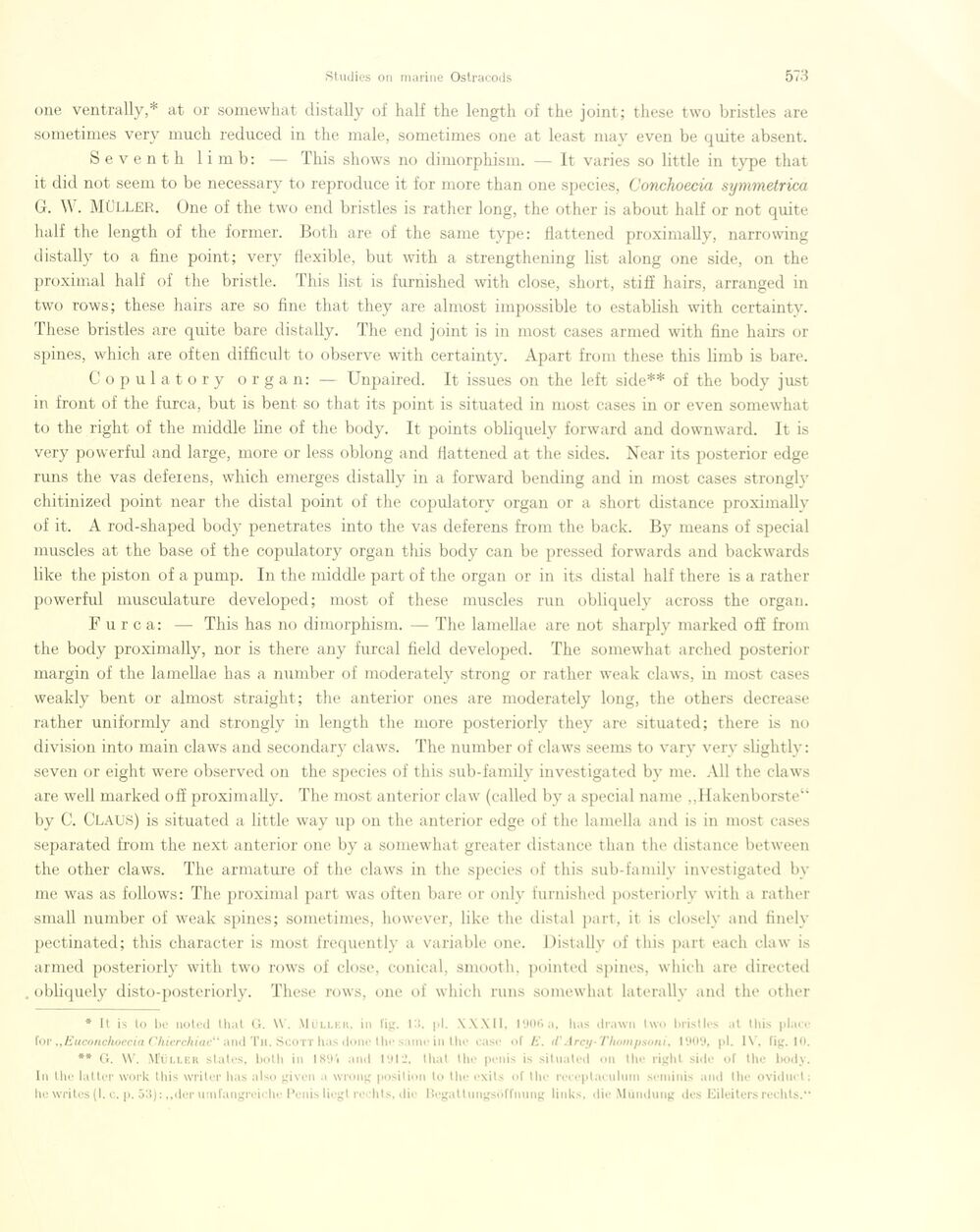
Full resolution (JPEG) - On this page / på denna sida - Sidor ...

<< prev. page << föreg. sida << >> nästa sida >> next page >>
Below is the raw OCR text
from the above scanned image.
Do you see an error? Proofread the page now!
Här nedan syns maskintolkade texten från faksimilbilden ovan.
Ser du något fel? Korrekturläs sidan nu!
This page has never been proofread. / Denna sida har aldrig korrekturlästs.
one ventrally,* at or somewhat distally of half the length of the joint; these two bristles are
sometimes very much reduced in the male, sometimes one at least may even be quite absent.
Seventh limb: — This shows no dimorphism. — It varies so little in type that
it did not seem to be necessary to reproduce it for more than one species, Conchoecia symmetrica
G. W. MULLER. One of the two end bristles is rather long, the other is about half or not quite
half the length of the former. Both are of the same type: flattened proximally, narrowing
distally to a fine point; very flexible, but with a strengthening list along one side, on the
proximal half of the bristle. This list is furnished with close, short, stift’ hairs, arranged in
two rows; these hairs are so fine that they are almost impossible to establish with certaintv.
These bristles are quite bare distally. The end joint is in most cases armed with fine hairs or
spines, which are often difficult to observe with certainty. Apart from these this limb is bare.
Copulatory organ: — Unpaired. It issues on the left side** of the body just
in front of the furca, but is bent so that its point is situated in most cases in or even somewhat
to the right of the middle line of the body. It points obliquely forward and downward. It is
very powerful and large, more or less oblong and flattened at the sides. Near its posterior edge
runs the vas deferens, wliich emerges distally in a forward bending and in most cases strongly
chitinized point near the distal point of the copulatory organ or a short distance proximally
of it. A rod-shaped body penetrates into the vas deferens from the back. By means of special
muscles at the base of the copulatory organ this body can be pressed forwards and backwards
like the piston of a pump. In the middle part of the organ or in its distal half there is a rather
powerful musculature developed; most of these muscles run obliquely across the organ.
Furca: — This has no dimorphism. — The lamellae are not sharply marked oft from
the body proximally, nor is there any furcal field developed. The somewhat arched posterior
margin of the lamellae has a number of moderately strong or rather weak claws, in most cases
weakly bent or almost straight; the anterior ones are moderately long, the others decrease
rather uniformly and strongly in length the more posteriorly they are situated; there is no
division into main claws and secondary claws. The number of claws seems to vary very slightlv :
seven or eight were observed on the species of this sub-family investigated by me. All the claws
are well marked oft proximally. The most anterior claw (called by a special name „Hakenborste“
by C. Claus) is situated a little way up on the anterior edge of the lamella and is in most cases
separated from the next anterior one by a somewhat greater distance than the distance between
the other claws. The armature of the claws in the species of this sub-family investigated by
me was as follows: The proximal part was often bare or only furnished posteriorly with a rather
small number of weak spines; sometimes, however, like the distal part, it is closely and finelv
pectinated; this character is most frequently a variable one. Distally of this part eacli claw is
armed posteriorly with two rows of close, conical, smooth, pointed spines, which are directed
obliquely disto-posteriorly. These rows, one of which runs somewhat laterally and the other
* It is to be noted that G. \V. Müllkii, in fig. L>, pl. \X\II, 1906a, lias drawn two bristles at this place
For „Euconchoecia Chierchiae“ and Tu. Scott has done the vime in the easr of E. d’Arcy- l’hompsuni, 1909, pl. I\. Fig. 10.
** G. W. MIüller states, both in 189» and 191*. thal the penis is situated on the right side of the body.
In the latter work tins writer lias also given a wrong position to the exits of the receptaculum seminis and the oviduct:
lie writes (1. c. p. 53): „der umfangreiche Penis liegt rechts, die Begattungsöffnung links, die Mündung des Eileiters rechts.“
<< prev. page << föreg. sida << >> nästa sida >> next page >>